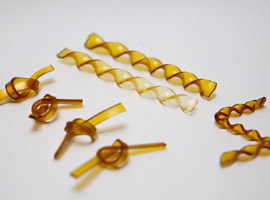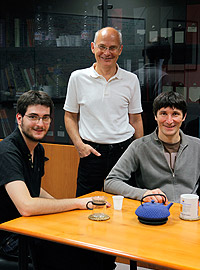
Différentes formes possibles de ce matériau - The material can take various forms
© CNRS Photothèque / ESPCI / Cyril FRÉSILLONA common feature of sailboards, aircraft and electronic circuits is that they all contain resins used for their lightness, strength and resistance. However, once cured, these resins can no longer be reshaped. Only certain inorganic compounds, including glass, offered
this possibility until now. Combining such properties in a single material seemed impossible until a team led by Ludwik Leibler, CNRS researcher at the Laboratoire “Matière Molle et Chimie” (CNRS/ESPCI ParisTech), developed a new class of compounds capable of this remarkable feat.
Reshape hardened resins: impossible
Replacing metals by lighter but just as efficient materials is a necessity for numerous industries, such as aeronautics, car manufacturing, building, electronics and sports industry. Due to their exceptional
mechanical strength and thermal and chemical resistance, composite materials based on thermosetting resins are currently the most suitable. However, such resins must be cured in situ, using from the outset the definitive shape of the part to be produced. In fact, once these resins have hardened, welding and repair become impossible. In addition, even when hot, it is impossible to reshape parts in the manner of a blacksmith or glassmaker.
This is because glass (inorganic silica) is a unique material: once heated, it changes from a solid to a liquid state in a very progressive manner (glass transition), which means it can be shaped as required without using molds. Conceiving highly resistant materials that can be repaired and are infinitely malleable, like glass, is a real challenge both in economic and ecological terms. It requires a material that is capable of flowing when hot, while being insoluble and neither as brittle nor as “heavy” as glass.
A new revolutionary material

Ludwik Leibler et une partie de son équipe - Ludwik Leibler and part of his team © CNRS Photothèque / Cyril FRESILLONFrom ingredients that are currently available and used in industry (epoxy resins, hardeners, catalysts, etc.), researchers from the Laboratoire “Matière Molle et Chimie” (CNRS/ESPCI ParisTech) developed a novel organic material made of a molecular network with original properties: under the action of heat, this network is capable of reorganizing itself without altering the number of cross-links between its atoms. This novel material goes from the liquid to the solid state or vice versa, just like glass. Until now, only silica and some inorganic compounds were known to show this type of behavior. The material thus acts like purely organic silica. It is insoluble even when heated above its glass transition temperature.
Lightness, resistance, insolubility...
Remarkably, at room temperature, it resembles either hard or soft elastic solids, depending on the chosen composition. In both cases, it has the same characteristics as thermosetting resins and rubbers currently used in industry, namely lightness, resistance and insolubility. Most importantly, it has a significant advantage over the latter as it is reshapeable at will and can be repaired and recycled under the action of heat. This property means it can undergo transformations using methods that cannot be envisaged either
for thermosetting resins or for conventional plastic materials. In particular, it makes it possible to produce shapes that are difficult or even impossible to obtain by molding or for which making a mold is too
expensive for the envisaged purpose.
Priscilla Dacher : 01 44 96 46 06
priscilla.dacher@cnrs-dir.fr
Contact researcher :
Ludwik Leibler : 01 40 79 51 25
ludwik.leibler@espci.fr
Used as the basis of composites, this new material could therefore favorably compete with metals and find extensive applications in sectors as diverse as electronics, car manufacturing, construction, aeronautics or printing. In addition to these applications, these results shed unexpected light on a fundamental problem: the physics of glass transition.
This work was supported in particular by CNRS, ESPCI ParisTech and the Arkema group.
Silica-like malleable materials from permanent organic networks. _ Damien Montarnal, Mathieu Capelot, François Tournilhac and Ludwik Leibler.
Science. 18 novembre 2011.
Source : CNRS press release







